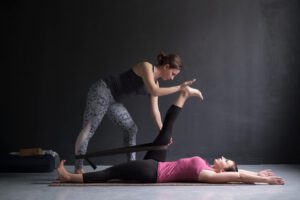The Basics of Mobility
July 17, 2023Mobility and flexibility are often seen as synonymous. Mobility and flexibility are certainly linked together, but thinking they are the same exact mean is incorrect. To further explain this, flexibility is the ability of a muscle or muscle group to lengthen passively through a range of motion (ROM). On the other hand, mobility is the ability of a joint to move actively through a ROM. The two keywords in those definitions are passively and actively. Together, mobility and flexibility can reduce the risk of injury and increase strength and muscle mass!
Flexibility is a component of mobility. Mobility is a more global or “functional” capacity that carries over to day-to-day activities and athletic endeavors. It is an indication of how well and efficiently we move and even helps us ward off injuries. To manage your injury risk, you want to minimize the gap between your passive (flexibility) and active (mobility) ROM. 
Your passive ROM is the range ROM at a joint that can be achieved when an outside force moves the body part. For example, if you lie on your back and someone else lifts your leg up to stretch your hamstrings. Your active ROM, however, is the motion at a joint that you can achieve by contracting muscles to create movement.
For example, lying on your back and contracting your hip flexors to lift your leg up and stretch the hamstrings. Many people have a much larger passive than active ROM. This increases injury risk. Outside of your active range, you lack control. Lack of control means you lack the strength or coordination to enter and exit the range safely. Sometimes life or sports puts you into these ranges. If you cannot control them, the risk of injury is high. If you are flexible in static passive stretches but lack mobility, it indicates you probably lack stability or strength.
Stability = ability to resist force
Strength = ability to exert force
To improve your mobility most people just do passive static stretches. Unfortunately, this is only part of the picture and often is not addressing the issue that is limiting mobility. In most cases, they actually need to increase stability and strength to showcase an increased active range of motion (mobility).
Going back to static stretching, this type of stretching often misses the target. Mobility is more effective than static stretching because it targets both movement and control. The body/brain is smart. Their best interests are to protect themselves. An example of this protective nature is that your body will not allow you to get into positions you cannot control. If you lack stability or strength in a certain position you risk injury. Consequently, the body will try and prevent you from getting into this position. This is all done in an effort to keep you safe.
 To develop mobility, you must develop the requisite stability and strength in these ranges so that your nervous system allows you to access them. This means your mobility routine is not going to be 20 mins of trying to contort yourself into pretzel-like shapes, holding each stretch for what feels like an eternity. Instead, it will be a combination of stretches, activation drills, and exercises designed to stretch, stabilize, and strengthen you to create lasting mobility improvements.
To develop mobility, you must develop the requisite stability and strength in these ranges so that your nervous system allows you to access them. This means your mobility routine is not going to be 20 mins of trying to contort yourself into pretzel-like shapes, holding each stretch for what feels like an eternity. Instead, it will be a combination of stretches, activation drills, and exercises designed to stretch, stabilize, and strengthen you to create lasting mobility improvements.
3 Common Mobility Issues
The three most common areas that I see when it comes to people lacking mobility are thoracic spine, shoulders, and hips.
1. Thoracic Mobility
Thoracic spine mobility is an extremely important, and oftentimes overlooked, component to a variety of dysfunctions. Poor thoracic mobility can affect your shoulders, neck, low back, and hips very easily. Unfortunately, our modern sedentary lifestyles mean poor thoracic mobility is very common. Sitting for long times, hunched over computer screens and smartphones, has placed us in a flexed thoracic position and led to a relatively stiff forward posture. A lack of thoracic mobility is a precursor to neck, shoulder, and lower back pain.
2. Shoulder Mobility
The ability to take your shoulder into full flexion (arms overhead) is crucial to safely train overhead movements. Full shoulder flexion while maintaining external rotation is of the upper arm is optimal. Most people lack this range and compensate by arching their lower back to get into the overhead position. This places a lot of strain on the lower back. This lack of shoulder mobility is often driven by poor thoracic extension which then creates faulty mechanics to reach overhead.
3. Hip Mobility
A lack of hip mobility means you will use compensatory strategies to hit certain ranges. Doing so means you run the risk of exposing other parts of your body to excessive strain. The faulty movement mechanics caused by insufficient hip mobility can drive up or down the chain to cause issues. A lack of hip mobility has been shown to contribute to lower back pain, hip osteoarthritis, groin pain, knee injuries, and ankle pain.
Effective Mobility Training
Mobility training is a means to an end. Adequate mobility allows you to train optimally. It creates the potential for you to train for strength and muscle mass in the most effective way possible. Without enough mobility, you will have to compromise on certain movement patterns and find workarounds to challenge muscles in certain positions. You can gain strength and size without great mobility, but you’ll be fighting an uphill battle that carries an increased risk of injury.
As with most physical capacities, it is much easier to maintain something you have developed than it was to develop it in the first place. Consequently, this means the amount of time dedicated to mobility work should reduce as you improve it. It also means more time should be spent on developing areas you are deficient in mobility-wise than areas you have the required levels. This frees up more time to invest in developing what you lack.
If you need extra guidance in your fitness journey, please reach out to KB Fitness Solutions. Our team of certified fitness professionals will be glad to help you achieve what you are meant to achieve!





